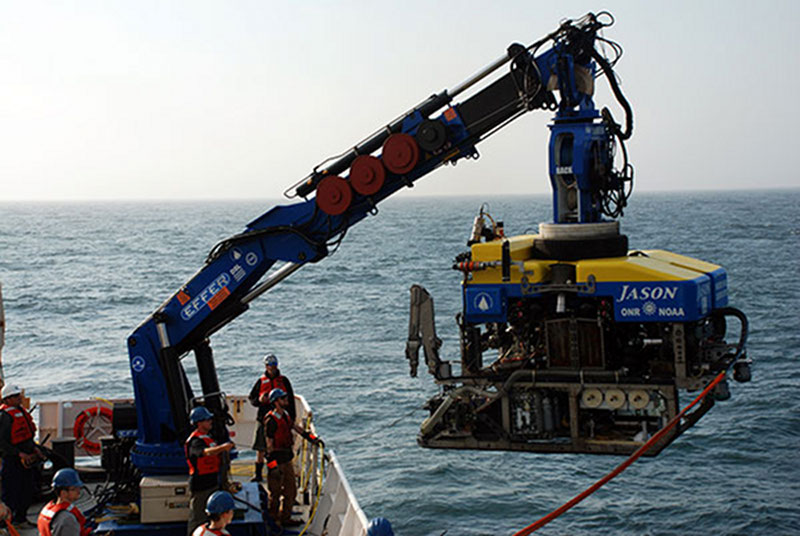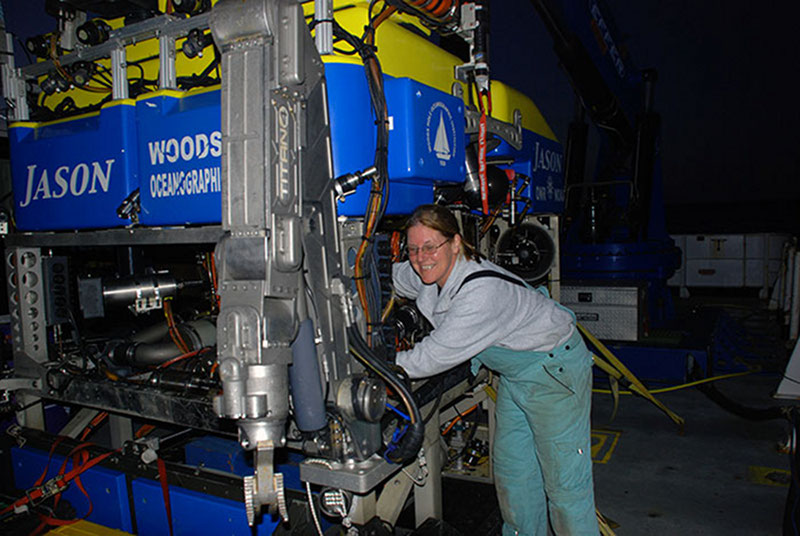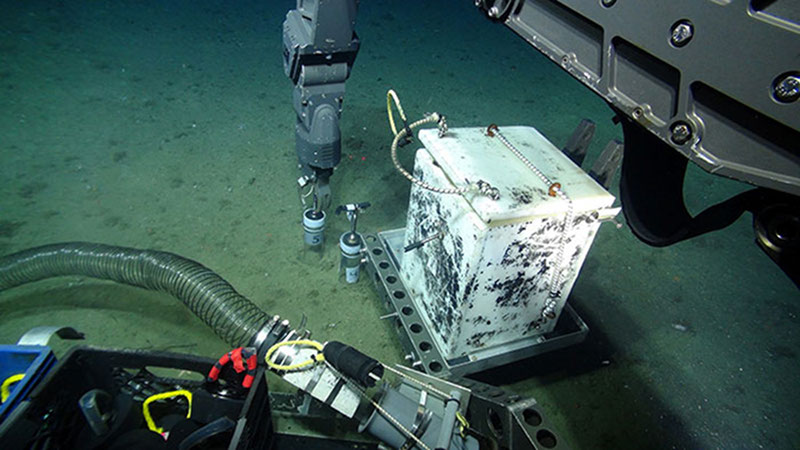
By Lisa Borden, The Jason ROV Team - Woods Hole Oceanographic Institution
May 25, 2013

ROV Jason is launched from NOAA Ship Ronald H. Brown. Image courtesy of Deepwater Canyons 2013 - Pathways to the Abyss, NOAA-OER/BOEM/USGS. Download larger version (jpg, 4.8 MB).
Jason and Medea are a remotely operated vehicle (ROV) system designed and built by Woods Hole Oceanographic Institution’s Deep Submergence Laboratory to allow scientists access to the deep ocean, far beyond the depths a human can go. Jason was first launched in 1988, and the system has been used for hundreds of dives to hydrothermal vents in the Pacific, Atlantic, and Indian Oceans. ROV Jason is now in its second generation, with a sturdier, more advanced vehicle having been launched in 2002.
On this cruise, Jason visited deep-sea coral communities along muddy canyon walls, discovered a new chemosynthetic community, and explored deepwater shipwrecks, all without scientists leaving the deck of NOAA Ship Ronald H. Brown. Pilots and scientists work from a control room on the ship to monitor Jason’s instruments and video while maneuvering the vehicle. Below Lisa Borden answers some frequently asked questions about Jason.
Jason cruise teams typically include 10 members. There are three rotations of operations: engineer, pilot, and navigator. We also have a person who controls all data and video recording. Additionally, all members are required to assist in launch/recoveries, pre-dives, post dives, and vehicle maintenance.

Eddie Dow checks to make sure all of the systems on ROV Jason are prepared for the dive. Image courtesy of Deepwater Canyons 2013 - Pathways to the Abyss, NOAA-OER/BOEM/USGS. Download larger version (jpg, 5.0 MB).
The combination of versatility, robustness, and technical ability makes Jason a special vehicle. It is very transportable and adaptable to various platforms; it does not have rechargeable power limitations; is good to 6,500 meters; and it has high-end data, video, and vehicle sensors. Jason is built to withstand 10,200 psi of pressure, which it experiences at a depth of 6,500 meters.
Jason uses ship power for its input, then transforms that power into better ranges for operations. The thrusters use AC power, vehicle lights and sensors use DC power, and the manipulators use hydraulics.

Lisa Borden prepares ROV Jason for the final dive of the project. Image courtesy of Deepwater Canyons 2013 - Pathways to the Abyss, NOAA-OER/BOEM/USGS. Download larger version (jpg, 5.3 MB).
The manipulator arms are hydraulically controlled. The pilot moves the arms remotely with a “master” controller, much like a video game controller. When the pilot makes a move with the master, the arm will make the same movement on the ocean floor.
The longest dive to date for Jason was seven days. Seven days of 24 hour operations without a recovery is a testimony to Jason’s robustness. This dive occurred off the northwestern coast of the U.S., around the Juan de Fuca plate.

ROV Jason collects push-core samples during the Deepwater Canyons expedition. Image courtesy of Deepwater Canyons 2013 - Pathways to the Abyss, NOAA-OER/BOEM/USGS. Download larger version (jpg, 5.8 MB).
Having two science legs for the same cruise doesn’t occur often and the fact that one leg focused on biology while the second leg focused on maritime archaeology was different. It was a diverse cruise.
If there are problems with any of Jason’s subsystems during a dive, the operations team will try to solve them remotely. If corrective action fails, the team will try to continue the dive without the problematic device and will troubleshoot after the dive. A major failure or power issue would require immediate recovery and problem solving on deck.
A degree in mechanical engineering, electrical engineering, or physics is desirable for working with Jason. Experience on boats is always helpful. To become a Jason pilot, you have to learn all about the vehicle systems and understand how scientists want to use it. Piloting Jason can be intense sometimes because of various factors like weather, sea-bottom terrain, and the desire to get really good samples.